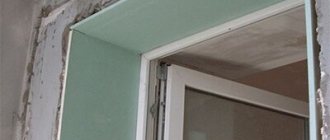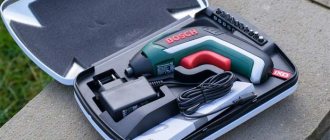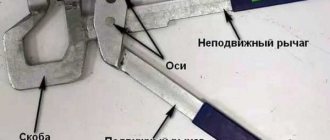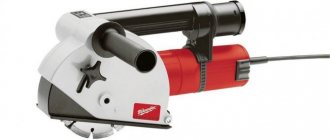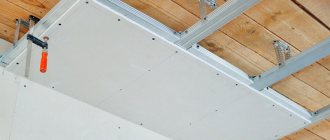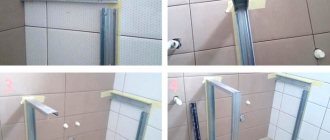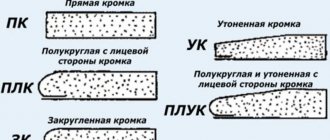If you have encountered massive tightening of self-tapping screws, especially in an awkward position on a stepladder (for example, when installing gypsum boards on the ceiling), the idea of automating the feeding process has probably occurred to you.
In order not to waste time installing the next screw in the head, multi-charge systems for supplying fasteners to the work area have been developed - belt mechanisms. They can be included in the screwdriver kit, or come in the form of a replaceable attachment.
Nozzle and its advantages
Initially, it should be noted that manufacturers produce not only attachments for screwdrivers, but also full-fledged power tools that are designed directly for the quick installation of plasterboard sheets, as well as carrying out other actions to secure fasteners. You can install such attachments in a regular screwdriver if it has a special design designed to be secured in a special chuck. Typically, such devices are called universal, since they can be used with different tools. Their main drawback is that they are produced by Chinese manufacturers, so we cannot talk about the long service life of such devices.
This is interesting!
A power tool that is designed to work in tandem with such attachments is called a band screwdriver.
They are not only battery-powered, but also mains-powered. Network devices are more like drills, which is why they are often called band drills. A belt attachment for a screwdriver is a device that is mounted in the chuck of a power tool and is intended for installation of fasteners - metal self-tapping screws. The special design of the device allows you not only to act on fasteners by screwing them, but also to automatically recharge them. Before we find out what types of attachments for belt screwdrivers are divided into, let’s look at the advantages of using such devices.
- Easy to use. This is due to the special design of the device. Screwing of self-tapping screws occurs quickly due to their automatic feeding, which is realized through the use of a special tape on which the corresponding number of fasteners is located. After screwing one self-tapping screw, automatic recharging occurs, and while the master changes the position of the tool, it is ready for use
- Ability to carry out work independently. This is relevant when installing ceiling plasterboard. The master holds a power tool with one hand and holds a sheet of drywall with the other
- Increased safety - Operation of the tool completely eliminates various injuries that can often occur when working with a conventional screwdriver with bits. The master who carries out the work does not come into contact with the fasteners at all, so the risk of injury is reduced to zero
- Fasteners are stored conveniently, which is due to their location on the tape. They will never get lost, will not pop out when screwing them in, and you won’t need to take them out of your pocket and attach them to the bat every time
- Work can be carried out with self-tapping screws of different lengths, for which there is a regulator in the design of the nozzle
- Possibility of recharging the tape with fasteners, but no more than 1-2 times. Once the tape is empty, there is no need to rush to dispose of it. To do this, you need to purchase a package of conventional fasteners and load them into the tape. However, you should not reuse the tape more than 2-3 times, as it also tends to wear out. The tape is responsible for centering the self-tapping screws, and as soon as the installed fastener is not level, it will not be possible to screw it in correctly. Many craftsmen try to restore the serviceability of the tape with their own hands, but this is not recommended, since they are intended exclusively for one-time use
- There is no need to control the size, or rather the depth of recessing of the fastener head. This indicator is controlled automatically, and depending on preferences, the amount of recessing is adjusted manually
The advantages of a belt attachment for a screwdriver are enough to make you think about purchasing it. Moreover, it can be purchased not only by craftsmen whose field of activity is related to construction, in particular, finishing work, but also by home craftsmen who plan to cover the walls with plasterboard in a house or apartment. To do this, you can use a regular screwdriver, but it is much easier, more efficient, faster and safer to carry out such work using a belt screwdriver.
This is interesting!
It is recommended to purchase the device together with a screwdriver, since the purchase of a universal attachment is not always characterized by quality, especially since the driven tool must have the appropriate parameters.
Selection options
Battery
The vast majority of screwdrivers are cordless models, unlike, say, drills, which mostly operate on mains power. Fortunately, modern batteries have sufficient capacity to ensure uninterrupted mechanization of monotonous and tedious work with a fairly intensive load. Even a capacity of 2 Ah makes it possible to screw in and tighten up to several hundred fairly large self-tapping screws (for example, 6 by 60 mm). Of course, a lot depends on the hardness of the wood and the condition of the tool itself - but, as practice shows, a set of a screwdriver and two batteries with a capacity of 1.5-2 Ah is enough for most craftsmen at home to work without downtime. However, if you plan to work with heavy loads (for example, with self-tapping screws 140-152 mm long), then you will need a powerful tool with high torque, which costs more. If an inexpensive screwdriver with one battery with a capacity of about 1.5 Ah in a set can be purchased for 2-3 thousand rubles, then a model with two batteries 2-3 Ah will cost 6-8 thousand rubles.
Lithium-ion batteries (Li-Ion) are characterized by high energy capacity, absence of self-discharge and memory effect. The advantage of nickel-cadmium (Ni-Cd) is the ability to operate in cold weather (–15-20 °C). It is advisable to choose models for which it is easy to select a replacement battery. In addition, many manufacturers - Bosch, Makita, Ryobi, Interskol, etc. - produce lines of power tools with the same batteries. You can purchase a tool without a battery and save 30-50% of the cost.
6 photos
Boris Bezel/Burda Media
Design features you need to pay attention to: 24 torque adjustment positions allow you to carefully tighten any screws.
Boris Bezel/Burda Media
Comfortable rubberized handle with a trigger-type start button.
Boris Bezel/Burda Media
Bit mounting options: ¼ inch HEX bit clamp.
Boris Bezel/Burda Media
Quick-release jaw chuck.
Leroy Merlin
A screwdriver with a nickel-cadmium battery, model Dexter, complete with a pair of 12 V batteries with a capacity of 1.3 Ah (RUB 1,900).
Leroy Merlin
Screwdriver with nickel-cadmium battery, 12 V screwdriver (China), one battery (RUB 576).
Bits
Often tool manufacturers offer home craftsmen whole sets of bits with the most exotic tips. But in practice, these sets are rarely used at least 30%. Most often, three types of bits are required: for hardware (that is, screws, self-tapping screws, screws, etc.) with a straight flat slot and for two types of cross slot (Philips and Posidriv). Each type of hardware is available in several sizes. In everyday life, you usually find hardware with cross-shaped slots PH1, PH2, PZ1, PZ2. And these are the bits you should definitely have at your disposal. It’s better not to skimp on them and buy high-quality bits, say Bosch, Milwaukee, Makita, made of high-strength steel - the bits themselves are relatively inexpensive, and working with them will be much more pleasant than with Chinese no name bits. And do not confuse Philips and Posidriv splines: with each you need to use only its bits, otherwise there is a high risk of tearing off the spline or damaging the bit if it is not strong enough.
ShutterStock
Select the right bit with the right type and size for the fastener slot, otherwise you risk wasting your energy and damaging both the fastener and the bit.
Ryobi
Two-speed drill/driver, with keyless chuck, Li-Ion battery and LED backlight, model Ryobi R18DD2-0, 18 V battery.
"Interskol"
Two-speed drill/driver, with keyless chuck, Li-Ion battery and LED backlight, model DA-14.4ER (Interskol), 14.4 V battery.
Types and sizes of some splines
| Spline type | Marking | Size (slot length), mm | |||||
| 1,5 | 2 | 3 | 4,5 | 6 | 8 | ||
| Philips | PH | PH000 | PH00 | PH0 | PH1 | PH2 | PH3 |
| Posidriv | PZ | PZ000 | PZ00 | PZ0 | PZ1 | PZ2 | PZ3 |
Power
The main criterion for the power capabilities of a screwdriver is its maximum torque, measured in N•m. Models in which this indicator is less than 15 N•m can be classified as relatively low-power. They are unlikely to cope with tightening the same 152 mm screws. The most universal and popular models have a maximum torque of 25=40 N•m. And for work that requires particularly high loads, models with a maximum torque of 80-100 N•m or more are produced. They can already be used when replacing car wheels and unscrewing tightly “stuck” nuts. For comparison: the torque of the brushless cordless screwdriver R18IDBL-0 (Ryobi) is 270 N•m. A pneumatic impact wrench in a car repair shop has a torque of 300-500 N•m.
The voltage of a battery does not determine its maximum power (some people mistakenly think that “the more volts, the stronger the screwdriver”). The amount of energy stored by the battery depends on it (capacity affects energy in direct proportion, and voltage - in a quadratic dependence) and operating time (the higher the voltage, the longer it will work). But you won’t be able to get all the energy stored in the battery instantly. Typically, batteries with a larger capacity can deliver more current.
The design of the belt device and its disadvantages
Like any power tool, a belt screwdriver has some disadvantages. Before learning about these shortcomings, you should first find out the main components of a screwdriver with a belt attachment. These components of a power tool with a removable attachment include:
- Aluminum and plastic housing
- A base for securing the heads of the screws, as well as moving the tape on which the screws are attached
- Screwdrivers for belt attachments are available in two versions - with horizontal and vertical motors
- Rechargeable battery in stand-alone units, as well as a wire for connecting to a socket in network devices
- Automatic tape feeder with fastening elements
- Mechanism for installing a new working “magazine” with screws
- Regulator of the length of used frosts
- A device for adjusting the depth of recessing of the screw head into a sheet of drywall
- Power tool reverse option
A tape with self-tapping screws is attached to the working base of the device in question. These are special self-tapping screws with a fine thread pitch, designed specifically for fastening sheets of drywall to a metal profile. For woodworking, you need to buy tapes with self-tapping screws that have a large pitch and are intended for such work.
Knowing the design of the electrically driven nozzle for tape screws, it is necessary to understand the disadvantages that exist when using the tool. These disadvantages include:
- The need to buy a full-fledged tool, since although the attachment is removable or detachable from the drive mechanism, it is impossible to install it in the chuck of a conventional screwdriver. That is why, if necessary, you have to buy a full set, the cost of which is 2 times higher than that of a regular cordless screwdriver. By the way, standalone models will cost more than networked ones. You can buy a universal attachment separately if you make sure that it is suitable for your existing tool
- Possibility of using only tape screws. If you run out of tape with fasteners, you can continue work after purchasing a new “magazine”. The device is designed only for working with tape fasteners, so if there are not enough screws to secure the sheet, you will need to use a regular screwdriver
- The complex mechanism makes the nozzle irreparable, so if it fails, you will need to purchase a new device of a similar design and brand. Such devices do not fail often, but only if it is a branded device from a well-known manufacturer
- The cost of tape screws is higher than buying them individually. The ability to reload the tape eliminates this drawback
- Presence of failures. If the fastening element is not screwed to the required recessing length, and the tool is disconnected, then you can continue tightening it with a regular screwdriver. This drawback is more likely related to the experience of the master, so it’s worth practicing a little to eliminate such a drawback
Based on these shortcomings, it is necessary to draw an appropriate conclusion about the rationality of such an acquisition. If work needs to be completed in a short time, then it is impossible to do it without a belt screwdriver. If you need to build an additional plasterboard ceiling in a scrap or apartment, then a regular screwdriver with a bat will do the job.
General technology for screwing in self-tapping screws
In order for the self-tapping screw to be securely fixed in the base material, when screwing it in, the following general technology should be followed:
- Use an awl or thin drill to mark the installation location;
- Place the tip of the product in the intended hole;
- carefully screw it in so that the position of the screw becomes stable;
- then continue screwing at maximum speed (if a screwdriver is used) and maximum force;
- at the last stage, reduce the force and speed to avoid damage to the screw and the material.
How to use a belt screwdriver with an attachment
The attachment in question is not universal, since it is intended only for quickly screwing in self-tapping screws when installing plasterboard sheets. However, manufacturers have provided for this drawback, so the design of most models of band screwdrivers has the ability to work with single self-tapping screws without a band. To do this, you need to dismantle the nozzle and continue screwing the fasteners, securing the adapter with the bit in the tool chuck.
To use the tool in question, you will need to prepare it for work. If to work with a conventional screwdriver it is necessary to secure a bit in a chuck of the appropriate type, then when using a tape device you will need to perform slightly different manipulations:
- Secure the attachment in the tool chuck by first inserting the extended bit, which is included with the tool.
- Depending on the length of the screws used, it is necessary to align the mechanism on the nozzle
- Attach the “magazine” to the device. In this case, it is important that there is a protrusion of the tape near the muzzle, and not a fastening element. The self-tapping screw is fed automatically when the “Start” button is pressed
- When the tool is ready for work, it is necessary to use it by pressing it against the plasterboard sheet, thereby grabbing it and connecting it to the profile
- It is first recommended to use a marker or pencil to mark the points where it is necessary to screw the fastening devices
- The process of working with such a tool is not only fast, but also effective, since all fasteners are recessed to the same amount, which depends on the set value
The speed of screwing self-tapping screws with a belt screwdriver is 2-3 times higher than using a conventional power tool. The design of the tool has a button fixation option, which plays a big role. After fixing the button, the tool operates continuously, and the master can only move the device in the required direction and press it to screw in the fasteners.
This is interesting!
The fastening devices are screwed in while the tool with the attachment is pressed against the plasterboard surface. After the fastener is “seated,” the unit snaps off, resulting in the movement of the tape with the self-tapping screws loaded in it.
A unique development - a magnetic screwdriver for non-contact use
The nozzle has not yet gone on sale; it is currently undergoing sea trials. The device is a plastic casing containing a clip with neodymium magnets.
The cage rotates - its axis is connected to the chuck of a standard screwdriver. Mating part: a screw with the same magnets, located in the cavity (inside) of the workpieces being connected. As a result of the interaction of magnets, the fastener is tightened, while it is not visible from the outside.
Advantages:
- You can assemble aesthetic structures without adhesive joints and visible fasteners.
- The strength of the assembly is ensured by the threaded connection.
- The attachment is universal – suitable for any screwdriver or drill.
- Based on the simplicity of the design, the cost is determined only by the cost of magnets.
Flaws:
- Special screw pairs equipped with powerful magnets are required.
- High cost of fasteners.
- Limited depth of screw placement - the distance between the magnets of the attachment and fastener should be as minimal as possible.
- Screws with magnets are of a fairly large diameter; there are restrictions on the minimum thickness of the workpieces.
What types of tape nozzles are available?
Manufacturers of construction power tools produce belt attachments with two types of drive mechanisms that differ in configuration. These are the following devices:
- With a regular removable nozzle. The ability to remove the nozzle allows you to tighten screws or tighten different types of fasteners. Such models are more popular and in demand, but their main disadvantage is that nozzles must be purchased together with the drive device
- Stationary mechanisms - these include screwdrivers that have a one-piece design of the drive mechanism with an attachment, and they are used exclusively for working with tape screws
Based on the type of power supply, band screwdrivers are classified into two main types - mains and cordless. Network devices are almost 2 times cheaper than battery-powered ones, but they have a big drawback - they are tied to an outlet. In addition, when working, a hanging cord causes a lot of inconvenience. It is especially inconvenient to work with a network tool when installing drywall on the ceiling.
The units under consideration also differ in characteristics such as the type of motor, which can be brushed or brushless. Brush devices are more popular, but their main disadvantage is the wear of the brushes, which depends on the frequency of use of the power tool. To resume normal operation of the tool, you will need to replace the graphite brushes.
Brushless devices are much more expensive, which is due to a number of their advantages:
- They have a long service life
- The engine runs quietly and smoothly
- They require no maintenance
In addition, these devices are lightweight and have overall dimensions, which has a positive effect on their operation.
Types of screwdrivers
Cordless screwdriver
Typically equipped with a built-in, non-replaceable 3.6 V battery and a socket for bits with a hexagonal shank. The main advantage of the tool is its compactness and low weight (200-300 g), and the disadvantage is the lack of rotation speed adjustment.
Screwdriver with impact and hammerless drill functions
The drill has a higher spindle speed. Therefore, such screwdrivers are equipped with a rotation speed switching mechanism (two speeds). Impact drills and screwdrivers come with axial impact (for drilling stone) and tangential impact (for developing high forces).
BoschCompact impact drill-driver EasyImpact 12 (Bosch).
Bosch
Cordless drill/driver of the UniversalDrill 18 series (Bosch).
Bosch
Cordless drill/driver of the UniversalDrill 18 series (Bosch).
AEG
Angular replacement attachment for drill/driver BBS12C2 (AEG).
AEG
Cam replacement attachment for drill/driver BBS12C2 (AEG).
Screwdrivers, impact wrenches
This is usually a professional technique. They are used with replaceable sockets for working bolts and nuts and feature the highest maximum torque.
GeenWorks
Powerful impact driver, model 24V GD24ID (GreenWorks), 24 V, 327 Nm.
GeenWorks
Powerful impact driver, model R18IDBL (Ryobi) with brushless motor, 18 V, 270 Nm.
- Tools
How to choose a drill: types, functions and top devices
Which screwdriver with a belt attachment should you choose?
After the appearance of the first screwdrivers, many modern manufacturers began to produce them in large quantities. Moreover, not only battery-powered models are produced, but also networked models. Such devices are intended for professional use when installing plasterboard sheets.
Each manufacturer equips its tools with additional options that greatly simplify construction and installation work. Before you buy an attachment with a screwdriver, you need to understand its technical capabilities and parameters. The ability to screw screws of different lengths depends on these parameters. The main role is played by the power of the electric motor. If this is a low-power screwdriver, then it is not recommended to use it for screwing fasteners into wood, as the motor can quickly burn out.
Manufacturers producing belt screwdrivers with attachments that are worth paying attention to:
- DeWalt
- Makita
- Hilti
- Bosch
- Metabo
- Senko
When purchasing, you need to take into account the price, since cheap models cannot guarantee a long service life of the equipment, while expensive models from well-known manufacturers can work for quite a long time. To summarize, it should be noted that the tool in question is worth purchasing for planned drywall installation work. The screwdriver attachment for drywall will allow you to complete the work not only quickly, but also efficiently.
What to use when you need to screw in a self-tapping screw
If there is only one self-tapping screw or if their number is very small, you can easily use a regular screwdriver. If you are assembling some complex structure with a large number of fasteners, then it would be better to arm yourself with a good-quality screwdriver.
To choose the right screwdriver, read our article, which we devoted specifically to this issue. The effectiveness of this device increases significantly if it is used with quality bits.
Now let's move on to the most important thing - screwing in the screws.
How to unscrew a self-tapping screw with a broken head
In order to remove a self-tapping screw with a damaged or completely broken head, you need to use a tubular drill for ceramics.
Would you like to adopt even more useful tips? Then read about 6 tricks and tricks that will make life easier for any driver on the road.
Did you like the article? Then support us, click
:
Source: novate.ru
CUTTING DISCS FOR SCREWDRIVER
These cutting discs are designed for a dremer, but they are also suitable for a screwdriver. They are very convenient for cutting something small from plastic or wood, where you can’t reach with an angle grinder and there is much less dust from it than from an angle grinder. The price of this set is 343 rubles - BUY
